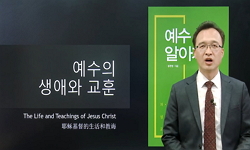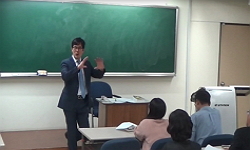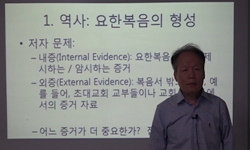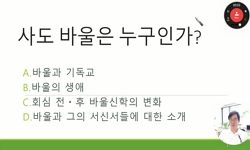본 연구는 러시아 타간카 극장의 <거장과 마르가리타> 재구축 작업을 통해 불가코프의『거장과 마르가리타』의 예수(예수아)에 대한 연극무대의 우회적 재현방식을 살핀다. 문학을 포...
http://chineseinput.net/에서 pinyin(병음)방식으로 중국어를 변환할 수 있습니다.
변환된 중국어를 복사하여 사용하시면 됩니다.
- 中文 을 입력하시려면 zhongwen을 입력하시고 space를누르시면됩니다.
- 北京 을 입력하시려면 beijing을 입력하시고 space를 누르시면 됩니다.

‘재현 불가능한 것’으로의 ‘예수’와 연극의 ‘우회적 재현: <거장과 마르가리타>의 ‘예수(예수아)’ 재현 방식을 중심으로 = A theatrical attempt to indirectly represent the unrepresentable: With a focus on the representation of Yeshua in The Master and Margarita
한글로보기https://www.riss.kr/link?id=A107374960
- 저자
- 발행기관
- 학술지명
- 권호사항
-
발행연도
2021
-
작성언어
-
- 주제어
-
등재정보
KCI등재
-
자료형태
학술저널
-
수록면
199-223(25쪽)
-
KCI 피인용횟수
0
- 제공처
-
0
상세조회 -
0
다운로드
부가정보
국문 초록 (Abstract)
본 연구는 러시아 타간카 극장의 <거장과 마르가리타> 재구축 작업을 통해 불가코프의『거장과 마르가리타』의 예수(예수아)에 대한 연극무대의 우회적 재현방식을 살핀다. 문학을 포함한 예술에서 예수를 어떻게 재현할 것인가 하는 문제는 쉽지 않았다. 러시아연극의 경우, 이콘의 정신 속에 나타나는 그러한 종교적 상징이어야 하는가, 인간의 특징을 충분히 살려 현시적이고 인간적인 자연스러움을 추구할 것인가 하는 질문들이 항시 있었다. 이 선택의 문제가 까다로웠던 것은, 예수를 재현 불가능한 것, 그래서 표상할 수 없는 것이라 전제했기 때문이다. 불가코프의 『거장과 마르가리타』 속 예수(예수아)의 표상은 ‘재현 불가능한 것’, ‘현시 할 수 없는 것’으로서의 예수그리스도를 우회적으로 재현하려는 문학적 전략의 측면에서 문제적이다. 본 연구는 연극무대에서 재현 불가능한 것에 대한 미학적 논의가 어떠한 방식으로 진행되었는가에 대한 사례분석으로의 가치를 지닌다. 이와 함께 불가코프의 소설『거장과 마르가리타』와 타간카 극장의 연극 <거장과 마르가리타>가 예술의 정치적, 윤리적, 미학적 체제에 대한 대항이라는 예술의 임무와 역할을 어떠한 방식으로 수행해 나갔는지를 확인해 나가고자 한다.
다국어 초록 (Multilingual Abstract)
An artistic drive to objectify and represent the unrepresentable has long been a limitation and challenge facing modern art. This desire stemmed from a question whether the chaotic domain of the senses and its logical, organized conceptualization can ...
An artistic drive to objectify and represent the unrepresentable has long been a limitation and challenge facing modern art. This desire stemmed from a question whether the chaotic domain of the senses and its logical, organized conceptualization can be represented. The unrepresentable has been the subject of aesthetic anguish among generations of philosophers, from Kant and Lyotard to Ranciere. In the context of the sublime defined by Kant and Lyotard, one of the artistic approaches to the unrepresentable is the existence of Jesus as a religious and mythological subject. The message of mercy and forgiveness proclaimed in the Gospels is the epitome of the sublime suggested by Kant. It is a prime example of the terrifying, the noble and the splendid sublime. The representation of Jesus in art and literature has been a contentious issue. In Russian theater, there has been a debate whether his depiction should remain as a spiritual or religious symbol in the icon or take on natural human characteristics. But this question is based on the premise that Jesus cannot be represented. The Master and Margarita by Mikhail Bulgakov sheds light on the moral and ethical values of Christianity that were completely denied in the atheistic post-revolution Soviet Union. Bulgakov brazenly discussed the humanistic teachings of Jesus of Nazareth in an era of atheism, which made his later works become a frequent target of state censorship. One of the main characters in the novel is Yeshua Ha-Notsri. Yuri Lyubimov’s 1977 production of The Master and Margarita at the Taganka Theatre in Moscow was a theatrical attempt to address the representation of Yeshua as the unrepresentable and the first stage adaptation of the novel in the Soviet Union. This paper aims to identify how Yeshua is depicted in Bulgakov’s novel by reconstructing the production at the Taganka Theatre. It will include an analysis of the current aesthetic debate about the unrepresentable in the theater community and study examples of how the unrepresentable are being indirectly represented within the limited genre of theater.
참고문헌 (Reference)
1 Scott, J. C., "지배, 그리고 저항의 예술: 은닉 대본" 후마니타스 2020
2 목정원, "재현불가능한 것을 우회하는 재현들 - 리오타르와 랑시에르를 넘어서" 예술과미디어학회 18 (18): 121-136, 2019
3 Ranciere, J., "자크 랑시에르와의 대화" 인간세상 2020
4 Ranciere, J., "이미지의 운명" 현실문화 2014
5 Wilde, O., "오스카 와일드 미학 강의: 사회주의에서의 인간의 영혼" 좁쌀한알 2018
6 이문원, "예수 드라마의 극적 사실주의에 관한 미학적 고찰 - <마태복음>과 <패션 오브 크라이스트>를 중심으로 -" 기독교학문연구회 17 (17): 147-174, 2012
7 심혜련, "아우라의 진화" 이학사 2017
8 Kant, I., "아름다움과 숭고함의 감정에 관한 고찰" 책세상 2005
9 Lenin, V. I., "사회주의와 종교" 19 : 32-37, 2006
10 Ranciere, J., "미학 안의 불편함" 인간사랑 2018
1 Scott, J. C., "지배, 그리고 저항의 예술: 은닉 대본" 후마니타스 2020
2 목정원, "재현불가능한 것을 우회하는 재현들 - 리오타르와 랑시에르를 넘어서" 예술과미디어학회 18 (18): 121-136, 2019
3 Ranciere, J., "자크 랑시에르와의 대화" 인간세상 2020
4 Ranciere, J., "이미지의 운명" 현실문화 2014
5 Wilde, O., "오스카 와일드 미학 강의: 사회주의에서의 인간의 영혼" 좁쌀한알 2018
6 이문원, "예수 드라마의 극적 사실주의에 관한 미학적 고찰 - <마태복음>과 <패션 오브 크라이스트>를 중심으로 -" 기독교학문연구회 17 (17): 147-174, 2012
7 심혜련, "아우라의 진화" 이학사 2017
8 Kant, I., "아름다움과 숭고함의 감정에 관한 고찰" 책세상 2005
9 Lenin, V. I., "사회주의와 종교" 19 : 32-37, 2006
10 Ranciere, J., "미학 안의 불편함" 인간사랑 2018
11 배철영, "리오타르의 뉴먼:현시할 수 없는 것으로서 순간 혹은 사건" 새한철학회 1 (1): 179-198, 2005
12 김원석, "러시아 햄릿" 연극과인간 2017
13 Gillespie, D., "러시아 영화-문화적 기억과 미학적 전통" 그린비 2015
14 Kazantzakis, N., "러시아 기행: 니코스 카잔차키스 여행기" 열린책들 2008
15 Žižek, S., "공산당 선언 리부트: 지젝과 다시 읽는 마르크스" 창비 2020
16 Вулгаков, М., "거장과 마르가리타" 민음사 2010
17 Урюпин, И., "Роман М.А. Булгакова "Мастер и Маргарита": мотивы головы и сер дца в контексте традиций русского религиозно-философского Ренессанса" АВ ТОРЕФЕРАТ 2004
18 Вулис, А., "Роман М. А. Булгакова «Мастер и Маргарита»" Художественная литера тура 1991
19 Любимов, Ю., "Рассказы старого трепача" Новости 2001
20 Виноградов, И., "П."Еретики" в литературе" Лицей 2003
21 Крючков, В., "П."Еретики" в литературе" Лицей 2003
22 Гудкова, В., "Осторожно: Шариков!" (44) : 1988
23 Чудакова, М., "О. Жизнеописание Михаила Булгакова" Книга 1988
24 Чудакова, М., "О «закатном романе» Михаила Булгакова. История создания и первой публикации романа «Мастер и Маргарита»" ЭКСМО
25 Ржевски, Л., "Литературоведческие проблемы и анали зы" New York University Press 1970
26 Лесскис, Г., "Комментарии к "Мастеру и Маргарите"" 5 : 1990
27 Карякин, Ю., "Выступление на Художественном Совете по спектаклю «Мастер и Мар гарита» 10 марта 1977 г" в Театре на Таганке
28 "Воспоминания о Михаиле Булгакове / Сост. Булгакова Е. С., Ляндрес С. А. Вступ. ст. В. Я. Лакшина. Послесл. М. О. Чуда ковой" Советский писатель
29 Соколов, Б., "Булгаковская энциклопедия" Локид. Миф 1977
30 Велехова, Н., "Бедный окровавленный Мастер" (5) : 1988
31 Лесскис, Г., "«Мастер и Маргарита» Булгакова: Манера повествования, жанр, макроком позиция // М: АН СССР. Сер. лит. и яз.- Т. 38, № 1"
32 Коваленко, Ю., "«Богодьяволы» Александра Трофимова // Страстной бульвар, 2012, 10 № 6-146"
33 "https://teatral-online.ru/news/485"
34 "https://fondlubimova.com/o-yurii-lyubimove/postanovki/postanovki-v-teatre-na-taganke-2/master-imargarita-1977/"
35 이승억, "1920년대 소비에트 드라마투르기에 나타난 극중극 연구- 룬츠, 불가코프, 트레티야코프, 마야콥스키를 중심으로 -" 한국노어노문학회 32 (32): 159-186, 2020
동일학술지(권/호) 다른 논문
-
초등학교 저학년 기본교과 연극 수업에 나타난 수행적 특성 고찰: 자신의 정체성을 찾아가는 여행 이야기를 중심으로
- 한국예술교육학회
- 염창선 ( Yum Chang-sun )
- 2021
- KCI등재
-
국악 제재 곡에 대한 청소년의 정서 반응이 선호도에 미치는 영향
- 한국예술교육학회
- 이수연 ( Yi¸ Soo Yon )
- 2021
- KCI등재
-
학생이 지각하는 음악학습에 대한 부모의 학습관여와 음악적 자기효능감 간의 관계: 성별 차이를 중심으로
- 한국예술교육학회
- 권슬기 ( Kwon Seulgi )
- 2021
- KCI등재
-
마리우스 폰 마이엔부르크 작(作) 『못생긴 남자』 ‘레테’ 연기 접근 방법 연구
- 한국예술교육학회
- 서창원 ( Seo Chang-won )
- 2021
- KCI등재
분석정보
인용정보 인용지수 설명보기
학술지 이력
| 연월일 | 이력구분 | 이력상세 | 등재구분 |
|---|---|---|---|
| 2022 | 평가예정 | 계속평가 신청대상 (계속평가) | |
| 2021-12-01 | 평가 | 등재후보로 하락 (재인증) |  |
| 2018-01-01 | 평가 | 등재학술지 유지 (등재유지) |  |
| 2015-01-01 | 평가 | 등재학술지 선정 (계속평가) |  |
| 2013-01-01 | 평가 | 등재후보학술지 유지 (기타) |  |
| 2012-01-01 | 평가 | 등재후보 1차 PASS (등재후보1차) |  |
| 2011-01-01 | 평가 | 등재후보 1차 FAIL (등재후보1차) |  |
| 2010-01-01 | 평가 | 등재후보학술지 유지 (등재후보1차) |  |
| 2008-01-01 | 평가 | 등재후보학술지 선정 (신규평가) |  |
학술지 인용정보
| 기준연도 | WOS-KCI 통합IF(2년) | KCIF(2년) | KCIF(3년) |
|---|---|---|---|
| 2016 | 1.03 | 1.03 | 1.12 |
| KCIF(4년) | KCIF(5년) | 중심성지수(3년) | 즉시성지수 |
| 1.09 | 1.01 | 1.115 | 0.25 |





 KCI
KCI KISS
KISS






